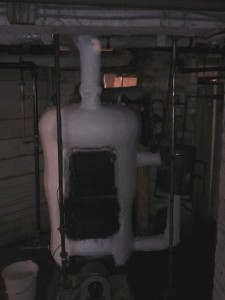The landlord problem
The incentive for energy efficiency is obvious for a home homer or business manager. Providing you can think beyond the immediate cash outlay there is a payback period that can be calculated – and the result promises to get better as energy efficient technology comes down in price and fossil energy prices go up.
But what about the owner of rental property? If the tenant pays for the energy then the landlord has virtually no incentive to update the heating and cooling equipment, or to spend extra money on appliances, lights and so on. Nor is there much incentive to weatherize or go high tech with solar, geothermal or the like.
Of course if the property owner provides the energy as part of the lease then the equation changes radically. But landlords are understandably reluctant to bundle the energy into the rent. From bitter experience, they know that if the heat is free then the thermostat will be set to toasty T-shirt temperatures while the birds outside fall frozen from the sky, and the house will be the most brightly lit on the street. Pricey, energy efficient appliances will be mistreated the same as the cheapest models from the discount store.
David MacKay in “Sustainable Energy – without the hot air” devotes about a page to the issue and concludes that “some sort of intervention is required”. Certainly true – however the realist is very suspicious of interventions without a lot of thought behind them. The road to unintended consequences is paved with good interventions.
Believers in the free market will claim that energy efficient apartments should command a higher rent because the rational tenant will make an informed decision to spend more rent in return for greater comfort and lower energy costs. One of the “interventions” briefly mentioned in the analysis above is a some sort of certificate the landlord can show the tenant to make those claims substantial. That seems like a good idea, but the required bureaucracy and attendant skullduggery feels oppressive. And tenants typically do not make fully informed decisions – the size of the rooms, good schools nearby, the view, where to find the cash for the rent and deposit and a dozen other concerns far outweigh any thought of energy cost.
There simply are not any good answers. Here is an article form Colombia, Missouri that basically says things will improve in time. (http://www.columbiamissourian.com/stories/2009/07/02/columbia-seeks-solutions-rental-housing-energy-demand/)
In New York City Mayor Bloomberg has proposed a plan initially aimed at buildings of over 50,000 sq. ft. – roughly 20+ apartments. This article (http://nreionline.com/brokernews/greenbuildingnews/news/bloomberg_energy_efficient_legislation_0505/) notes: “The devil is likely to be in the details” – not very surprising or original.
The realists modest proposal – admittedly informed by some self interest – is that we start at the worst possible point and simply subsidize small landlords massively (say at the 80% level) for replacement of antique heating systems. Of course landlords are not the most beloved of people – despite the fact that the great majority of them provide a very necessary service with efficiency and honesty. So the answer to that proposal by many (non-landlord) readers will be to tackle the issue by forcing the landlord to upgrade – upgrade or have your building declared unfit for occupation!
Yes, except that in exactly those areas where there is a need for good rental housing at reasonable cost, which equals low, if any, profit margins for the owner you will find the concentration of antique systems. Forcing the landlord to upgrade will force a rental increase. If no tenants are willing or able to rent at the new rates the building eventually becomes another casualty of the real estate crash.
If you think these antiques don’t exist you need only look at the basements of some old apartments and multi-family houses in the US North-East – in New York, Boston, Hartford and all the towns and cities between. You will find 100-year-old steam furnaces originally built for coal, converted to oil and sometimes further converted to natural gas. They keep the basement cozy, but provide terrible heating efficiency to the rest of the building.

This "snowman" unit hides in the dark confines of the basement and chews up energy. The attached hot water pre-heat tank made sense in the days of coal but wastes more heat now. The steam piping is insulated with asbestos (well encapsulated here - but often in poor condition). Replacement cost: $5000 for the asbestos removal, $5000 for the boiler replacement. According to the HVAC contractor no system exists that will qualify for government subsidies. The replacement cost wipes out more than a year of rental income.
The landlord problem is just another of the many issues that need to be solved at the policy and economic level. The technology exists, the eagerness to update is there, the long term benefits are obvious – but the initial expense is a hurdle that we either cannot or will not tackle – just yet.
[Update 8/16/2010]
This article in the NYT illustrates the landlord problem perfectly. With the hot, humid summer air-conditioners in those apartments where electricity is included in the rent are left on continually – even when people are on vacation! – so they can come back to a cool room.
Posted: August 11th, 2009 under Uncategorized.

Leave a Reply
You must be logged in to post a comment.